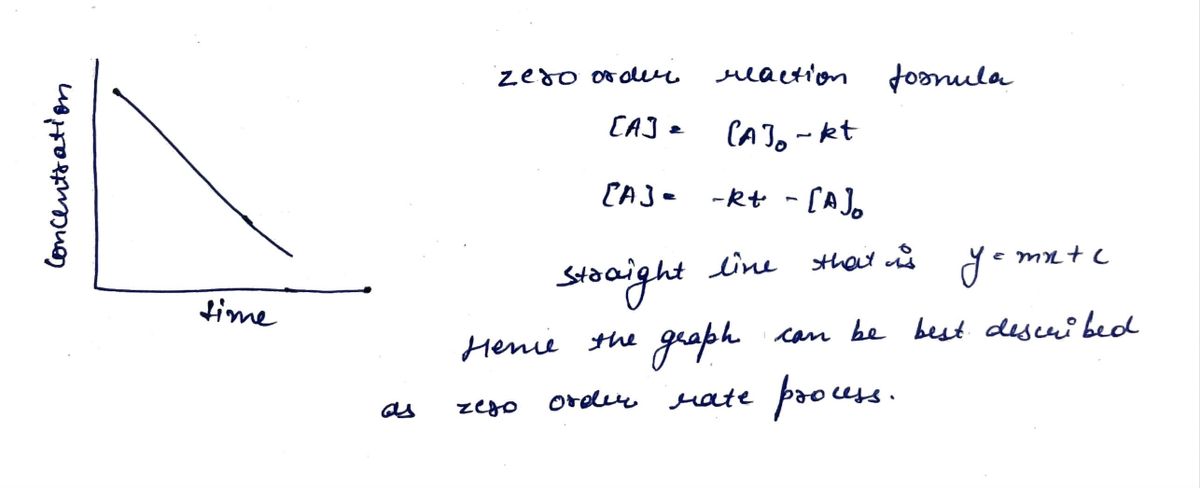Reaction Rate Graph: Concentration vs. Time Time ( Concentration Time() Graph a can best be described as Zero order or first order rate process Zero order rate process Second order rate process Zero order or second order rate process First order rate process First order or second order rate process We can determine the reaction order from Graph b by (select all that apply. incorrect choices will be penalized) 00000 doing nothing plotting the square root of concentration vs. time and getting a straight line. plotting In[A] vs. time and getting a straight line. plotting [A]2 vs. time and getting a straight line. plotting 1/[A] vs. time and getting a straight line.
Reaction Rate Graph: Concentration vs. Time Time ( Concentration Time() Graph a can best be described as Zero order or first order rate process Zero order rate process Second order rate process Zero order or second order rate process First order rate process First order or second order rate process We can determine the reaction order from Graph b by (select all that apply. incorrect choices will be penalized) 00000 doing nothing plotting the square root of concentration vs. time and getting a straight line. plotting In[A] vs. time and getting a straight line. plotting [A]2 vs. time and getting a straight line. plotting 1/[A] vs. time and getting a straight line.
Chemistry
10th Edition
ISBN:9781305957404
Author:Steven S. Zumdahl, Susan A. Zumdahl, Donald J. DeCoste
Publisher:Steven S. Zumdahl, Susan A. Zumdahl, Donald J. DeCoste
Chapter1: Chemical Foundations
Section: Chapter Questions
Problem 1RQ: Define and explain the differences between the following terms. a. law and theory b. theory and...
Related questions
Question
![Reaction Rate Graph: Concentration vs. Time
Concentration
Time (4)
Concentration
Time (e)
b.
Graph a can best be described as
Zero order or first order rate process
Zero order rate process
Second order rate process
Zero order or second order rate process
First order rate process
First order or second order rate process
00000
☆
We can determine the reaction order from Graph b by (select all that apply,
incorrect choices will be penalized)
doing nothing
plotting the square root of concentration vs. time and getting a straight line.
plotting In[A] vs. time and getting a straight line.
plotting [A]2 vs. time and getting a straight line.
plotting 1/[A] vs. time and getting a straight line.](/v2/_next/image?url=https%3A%2F%2Fcontent.bartleby.com%2Fqna-images%2Fquestion%2F80adb728-6954-4f8d-9107-41647af52006%2Fe7838aa1-c605-474a-a06e-fa572645d16a%2F11e4ws7_processed.jpeg&w=3840&q=75)
Transcribed Image Text:Reaction Rate Graph: Concentration vs. Time
Concentration
Time (4)
Concentration
Time (e)
b.
Graph a can best be described as
Zero order or first order rate process
Zero order rate process
Second order rate process
Zero order or second order rate process
First order rate process
First order or second order rate process
00000
☆
We can determine the reaction order from Graph b by (select all that apply,
incorrect choices will be penalized)
doing nothing
plotting the square root of concentration vs. time and getting a straight line.
plotting In[A] vs. time and getting a straight line.
plotting [A]2 vs. time and getting a straight line.
plotting 1/[A] vs. time and getting a straight line.
Expert Solution
Step 1

The slope is negative and when comparing the equation with y= mx + C , we can find that this is graph of zero order reaction .
B is correct option from a part - zero order process .
Trending now
This is a popular solution!
Step by step
Solved in 2 steps with 2 images

Knowledge Booster
Learn more about
Need a deep-dive on the concept behind this application? Look no further. Learn more about this topic, chemistry and related others by exploring similar questions and additional content below.Recommended textbooks for you

Chemistry
Chemistry
ISBN:
9781305957404
Author:
Steven S. Zumdahl, Susan A. Zumdahl, Donald J. DeCoste
Publisher:
Cengage Learning

Chemistry
Chemistry
ISBN:
9781259911156
Author:
Raymond Chang Dr., Jason Overby Professor
Publisher:
McGraw-Hill Education

Principles of Instrumental Analysis
Chemistry
ISBN:
9781305577213
Author:
Douglas A. Skoog, F. James Holler, Stanley R. Crouch
Publisher:
Cengage Learning

Chemistry
Chemistry
ISBN:
9781305957404
Author:
Steven S. Zumdahl, Susan A. Zumdahl, Donald J. DeCoste
Publisher:
Cengage Learning

Chemistry
Chemistry
ISBN:
9781259911156
Author:
Raymond Chang Dr., Jason Overby Professor
Publisher:
McGraw-Hill Education

Principles of Instrumental Analysis
Chemistry
ISBN:
9781305577213
Author:
Douglas A. Skoog, F. James Holler, Stanley R. Crouch
Publisher:
Cengage Learning

Organic Chemistry
Chemistry
ISBN:
9780078021558
Author:
Janice Gorzynski Smith Dr.
Publisher:
McGraw-Hill Education

Chemistry: Principles and Reactions
Chemistry
ISBN:
9781305079373
Author:
William L. Masterton, Cecile N. Hurley
Publisher:
Cengage Learning

Elementary Principles of Chemical Processes, Bind…
Chemistry
ISBN:
9781118431221
Author:
Richard M. Felder, Ronald W. Rousseau, Lisa G. Bullard
Publisher:
WILEY